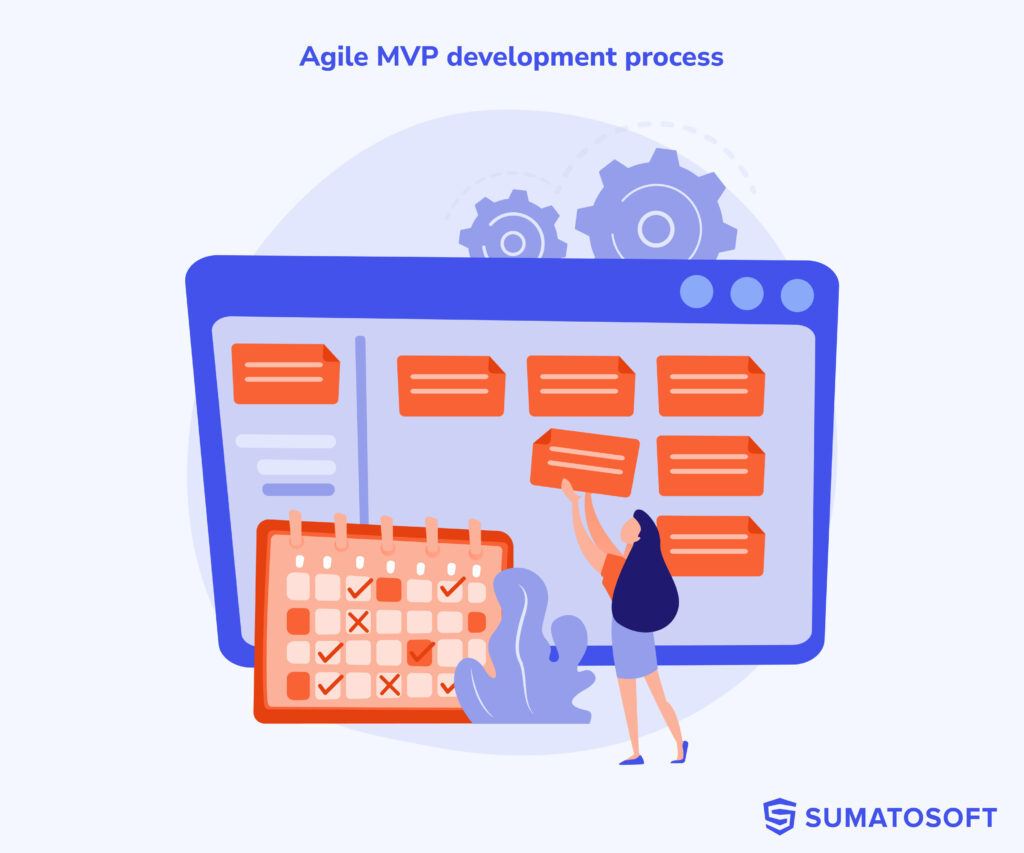MVP software development services
Get your startup business idea off the ground with our expertise in software development, accelerate time to market and optimize MVP development costs. Start fast, scale strong, become profitable.
Our MVP development services scope
We support startups through every stage of MVP development, providing the skills, tools, and guidance needed to launch quickly and grow strategically. We go far beyond code and provide expert support at every critical point. The complete list of our offerings to startups is here:
- plan and develop MVP from scratch;
- no-code/low-code and custom MVPs;
- help you shape your product idea and validate it;
- create detailed, investor-ready documentation and estimates;
- advice on the optimal technology use;
- support you post-launch with analytics, user feedback collection, and roadmap planning.

Why startups need an MVP
MVP requires a minimum budget and resources
MVP stands for Minimum Viable Product, which is the solution that contains only the core functionality needed to test the idea before full investment. As a result, developing MVP is an approach that requires minimum possible investment.

MVP eliminates uncertainty around product–market fit
The best approach to test product-market fit is to release the product to real users and gather their feedback. When developing an MVP, we identify the core feature that should attract users and build around it – enabling early feedback to see if it truly resonates with the audience.

MVP meets any pressure to launch fast
The most prominent MVP feature is quick time to market. MVPs contain the minimum possible features that allow startups to launch the product faster, avoid building unnecessary features, gain a competitive edge, and secure funding.

Your idea deserves more than a pitch deck!
Turn it into a working MVP with our expert dev team.
Advanced services we can help startups with
Our niche expertise in industries
Let us write words that guide our industry—multi-integrated, customizable, optimized for performance, optimized for budget and timelines, web and mobile, exceptional software. We combine our technical expertise, domain knowledge accumulated for over a decade, and well-established development processes to help startups launch reliable industry-specific solutions.
Healthcare MVP development
We develop digital tools and systems that modernize care delivery. We analyze needs, develop system architecture, and build multiple applications with respect to global and local regulatory requirements such as HIPPA, GDPR, FDA, HITECH, SSAE, FHIR. We also set up necessary integrations with any third-party solution, be it electronic health record systems, patient management software, billing modules, telemedicine, etc. We have expertise in building:
Education (E-learning) MVP development
We provide full-cycle eLearning us mvp software development services to help educational institutions and businesses build flexible, engaging, and scalable EdTech platforms. We support both asynchronous and synchronous learning models and ensure compliance with major standards (SCORM, xAPI, AICC), GDPR, and accessibility guidelines (WCAG 2.1). Solutions we develop:
Retail & E-commerce MVP development
We develop web and mobile solutions for retailers and e-commerce businesses, helping them grow their digital presence and improve customer engagement and overall user experience. We develop applications that support different models: B2C, B2B, multistore, and dropshipping. Our MVP app development services cover everything from system architecture and UI/UX design to developing a responsive and highly engaging storefront, using best industry practices to attract, engage, and retain customers. The solutions we develop:
AdTech & MarTech MVP development
Have something innovative in mind for the AdTech space? We’ve got you covered. We stay up to date with modern advertising trends and offer more than just standard CRM platforms or customer segmentation tools. Here’s what we can deliver:
FinTech MVP development
We help fintech startups quickly validate their financial products through secure, scalable MVPs. Whether it’s digital wallets, new payment systems, or a simple financial tool, we deliver MVPs that meet user’s needs and adhere to compliance standards, such as PCI DSS, GDPR, or other relevant financial industry rules. Our MVP development services for startups allow them to launch fast, attract early adopters, and gather feedback to evolve their financial products with confidence. Solutions we have expertise in:
Travel & Hospitality MVP development
We build MVPs for brave startups seeking opportunities to transform the travel experience. Be it a new booking system, guest engagement platform, or a widget that connects the website and the database, we launch lean, user-friendly products that connect travelers with your services. Products we help startups develop:
Media & Entertainment MVP development
Media and entertainment is a highly dynamic and vivid field that constantly evolves through new technologies, changing user behaviors, and fresh content formats. We know it, we monitor it, we implement it, we develop it. Our expertise encompasses creating classic solutions familiar to the industry, such as content management systems and distribution tools, as well as modern, innovative approaches like AI-assisted video editing, real-time personalization engines, and more. Here is what we offer:
Blockchain MVP development
We provide blockchain development services tailored for MVP-stage startups looking to launch quickly and securely. Whether you’re building decentralized identity verification tools, stablecoin-based payment apps, or AI-enhanced smart contracts, we help you move from concept to working prototype. Our team focuses on practical, scalable solutions that allow you to validate your idea, attract investment, and prepare for future growth.
Healthcare
We develop digital tools and systems that modernize care delivery. We analyze needs, develop system architecture, and build multiple applications with respect to global and local regulatory requirements such as HIPPA, GDPR, FDA, HITECH, SSAE, FHIR. We also set up necessary integrations with any third-party solution, be it electronic health record systems, patient management software, billing modules, telemedicine, etc. We have expertise in building:
Education (E-learning)
We provide full-cycle eLearning us mvp software development services to help educational institutions and businesses build flexible, engaging, and scalable EdTech platforms. We support both asynchronous and synchronous learning models and ensure compliance with major standards (SCORM, xAPI, AICC), GDPR, and accessibility guidelines (WCAG 2.1). Solutions we develop:
Retail & E-commerce
We develop web and mobile solutions for retailers and e-commerce businesses, helping them grow their digital presence and improve customer engagement and overall user experience. We develop applications that support different models: B2C, B2B, multistore, and dropshipping. Our MVP app development services cover everything from system architecture and UI/UX design to developing a responsive and highly engaging storefront, using best industry practices to attract, engage, and retain customers. The solutions we develop:
Marketing & Advertising
Have something innovative in mind for the AdTech space? We’ve got you covered. We stay up to date with modern advertising trends and offer more than just standard CRM platforms or customer segmentation tools. Here’s what we can deliver:
FinTech
We help fintech startups quickly validate their financial products through secure, scalable MVPs. Whether it’s digital wallets, new payment systems, or a simple financial tool, we deliver MVPs that meet user’s needs and adhere to compliance standards, such as PCI DSS, GDPR, or other relevant financial industry rules. Our MVP development services for startups allow them to launch fast, attract early adopters, and gather feedback to evolve their financial products with confidence. Solutions we have expertise in:
Travel & Hospitality
We build MVPs for brave startups seeking opportunities to transform the travel experience. Be it a new booking system, guest engagement platform, or a widget that connects the website and the database, we launch lean, user-friendly products that connect travelers with your services. Products we help startups develop:
Media & Entertainment
Media and entertainment is a highly dynamic and vivid field that constantly evolves through new technologies, changing user behaviors, and fresh content formats. We know it, we monitor it, we implement it, we develop it. Our expertise encompasses creating classic solutions familiar to the industry, such as content management systems and distribution tools, as well as modern, innovative approaches like AI-assisted video editing, real-time personalization engines, and more. Here is what we offer:
Blockchain
We provide blockchain development services tailored for MVP-stage startups looking to launch quickly and securely. Whether you’re building decentralized identity verification tools, stablecoin-based payment apps, or AI-enhanced smart contracts, we help you move from concept to working prototype. Our team focuses on practical, scalable solutions that allow you to validate your idea, attract investment, and prepare for future growth.
Free estimate for your startup
What kind of services you want to estimate?
How we build a Minimum Viable Product
The exact process depends on the project’s complexity and overall idea. This blueprint will likely match the final process that we will adjust to your project to build an MVP.
Duration: 2 weeks – 1 month
We begin MVP planning with discovery sessions to align on business goals, target users, and market positioning. Our key activities include:
- defining the product idea and concept;
- researching target market, user needs, and competitors;
- outlining monetization strategy and success metrics (KPIs);
- mapping core features and prioritizing them using proven techniques (Kano, RICE, etc.);
- designing MVP architecture with performance, security, and compliance in mind (HIPAA, PCI DSS, etc.);
- planning system integrations;
- choosing the optimal tech stack for speed, scalability, and future evolution.
Duration: 2-4 weeks
A Proof of Concept (PoC) is a lightweight version of your software idea (not the software itself) used to validate technical feasibility and demonstrate core functionality. PoC requires even less effort than MVP and helps reduce risk before committing to full-scale development, which is especially valuable for innovative or complex solutions.
PoC also plays a vital role in attracting investors: a well-executed PoC could demonstrate the viability of the idea, making it far easier to secure funding and build confidence with potential backers. It’s a great tool to demonstrate the potential of the idea before committing to its development.
Duration: 1 – 4 weeks
This step is all about setting up a clear and controlled environment for development. We define the project scope and budget, plan the timeline, break the work down into sprints, and set up the necessary infrastructure and environments (DEV, QA, DEMO, PROD). The PM aligns roles, deliverables, and communication processes to ensure a smooth development experience.
MVP Development can follow one of two paths:
No-code/Low-code MVP Development
Duration: 1 – weeks
Ideal for testing product demand quickly and at a low cost. For that purpose, we use landing page MVPs to present the coming-soon product without actually developing it. We use photos, wireframes, prototypes, and videos, to demonstrate the capabilities to the audience and check their interest.
Custom MVP Development
Duration: 2 – 6 months
Here we actually build a robust MVP with real functionality. We:
- design UX based on personas and user journeys;
- develop custom UI or use UI templates if the custom visualization is less important;
- build backend and frontend components, set up necessary integrations, deploy cloud infrastructure, connect necessary tools and frameworks;
- test throughout.
The result of our custom MVP software development services is a fully functional MVP with structured actual documentation about all the software’s capabilities.
We launch the MVP into the production environment. That means going online on the web and deploying mobile applications in mobile stores. Often, the product goes through an additional quality check using automotive tests, if any were prepared.
After the launch, we can keep collaborating. We monitor user behavior, validate or refine user stories, address risks, and adjust features as needed. If the MVP gains market validation or improves business processes, we continue evolving it or begin building a full-scale product to support growth.
MVP deliverables we prepare
Collaboration with us means full transparency in the way work is done. One of the key aspects is the tangible deliverables of our work produced at different stages during our collaboration.
Product Strategy & Planning
- validated product concept and user needs analysis;
- lean canvas or business model overview;
- feature roadmap and MVP scope definition;
- cost and timeline estimation;
- regular detailed reports about project health and status;
- risk assessment and mitigation analysis;
- product limitation document.
Design
- wireframes, mockups, and clickable prototypes;
- development-ready UI/UX designs;
- UI-kit to simplify the development process;
- style-guides.
Engineering
- technical architecture and tech stack recommendation;
- calable backend and API;
- secure and optimized infrastructure setup;
- fully functional MVP ready for deployment.
Quality & Growth Readiness
- QA reports and test documentation;
- test cases for test automation;
- post-launch performance metrics and next-step recommendations.
MVP to full product: after-launch support
Our partnership doesn’t end at MVP. After the launch, we continue to support you with both quick-impact initiatives and long-term support activities.
Got a vision? Let’s build its first proof!
Book a free strategy call and get expert feedback on your MVP scope.
Cost & timeline
The cost and timeline for MVP development vary based on the solution type, industry, and scope. On average, most MVPs take 2 to 6 months to build and fall within the $25K to $150K range. To make it easier to navigate, we’ve grouped MVPs into three tiers:
Tier 1: basic MVPs
$25K–$60K / 1–3 months
Simple web and mobile applications, e-commerce platforms, some AI-powered solutions, and IoT applications with small IoT fleets. This MVP tier is typically chosen by startups in industries such as retail, travel & hospitality, education, LegalTech, and real estate.
Tier 2: standard MVPs
$60K–$120K / 2–4 months
Suitable for more complex platforms like marketplaces, most IoT applications, feature-rich web and mobile apps, and early-stage SaaS products. This tier is commonly used in industries such as HRTech, EdTech, Agritech, Automotive, Social Media & Networking, Insurtech, and Education.
Tier 3: enterprise MVPs
$120K–$200K / 4–6 months
Built for industries like healthcare, fintech, logistics & supply chain, energy & utilities, smart cities, and cybersecurity – where advanced and complex infrastructure, strict compliance, high system scalability, and multiple integrations are mandatory requirements that can’t be ignored or skipped.
Our recent works
Key tech stack we work with
Idea-stage? We turn that into clickable reality.
Start with a free discovery consultation.
Since 2012, we have successfully assisted 100+ startups in turning their ideas into reality.
Why entrust MVP development to us
After 13 years on the market, we know software development for startups inside out. So, we adjust our MVP software development services to provide everything needed to develop your MVP application, from building a Lean Canvas to the release of a fully functioning MVP.
- Accurate and realistic cost estimation – our cost and time estimates are based on the analysis of your requirements, business goals, and user needs. You’ll get a clear budget and timeline — no guesswork, no surprises.
- We speak your language – we know how startups work: fast iterations, shifting priorities, and tight deadlines. We stay flexible, transparent, and proactive.
- More than MVP developers, we are your tech partner – whether you need advice on choosing the right tech stack, developing your architecture, or planning future releases – we’re here not just to code, but to guide.
- Result-oriented – our goal is to help startups grow, not just to deliver software.

Awards & recognitions
Let’s start
If you have any questions, email us info@sumatosoft.com

FAQ
What are MVP development services?
MVP software development services are professional services provided by software development companies. Its goal is to help startups validate their idea by quickly building a product with just enough features and attracting early adopters. SumatoSoft provides professional MVP development services in the USA.
What does MVP stand for in software development?
MVP stands for Minimum Viable Product – the product with a minimum number of features to stay viable on the market. As you can see, the name clearly speaks for itself.
What are MVP services?
MVP app & software development services include everything needed to build and launch a functional software product: business analysis, UI/UX design, development, QA, and post-launch support.
How much does an MVP development cost?
The average cost of an MVP software development for startups may be between $10K and $100K; as we mentioned above, pricing, as well as the time, depends entirely on the complexity of the MVP concept and other factors such as platform (web, mobile, IoT), technologies used, innovations required.
What comes after an MVP?
When you tested and proved your business idea with the MVP, the next step is fully-functional product development. Based on the feedback from the users, you and the app development team will be able to define what features your application should have and their priorities.
















